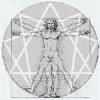“The teaching of the three forces is at the root of all ancient systems. The first force may be called active or positive; the second, passive or negative; the third, neutralizing. But these are merely names, for in reality all three forces are equally active and appear as active, passive, and neutralizing, only at their meeting points, that is to say, only in relation to one another at a given moment. The first two forces are more or less comprehensible to man and the third may sometimes be discovered either at the point of application of the forces, or in the ‘medium,’ or in the ‘result.’ But, speaking in general, the third force is not easily accessible to direct observation and understanding. The reason for this is to be found in the functional limitations of man’s ordinary psychological activity and in the fundamental categories of our perception of the PHENOMENAL WORLD, that is, in our sensation of space and time resulting from these limitations. People cannot perceive and observe the third force directly any more than they can spatially perceive the ‘fourth dimension.’ Fragments: Four
“But at the beginning it is enough to understand the general principle: every phenomenon, of whatever magnitude it may be, is inevitably the manifestation of three forces; one or two forces cannot produce a phenomenon, and if we observe a stoppage in anything, or an endless hesitation at the same place, we can say that, at the given place, the third force is lacking. In trying to understand this it must be remembered at the same time that people cannot observe phenomena as manifestations of three forces because we cannot observe the objective world in our subjective states of consciousness. And in the subjectively observed PHENOMENAL WORLD we see in phenomena only the manifestation of one or two forces. If we could see the manifestation of three forces in every action, we should then see the world as it is (things in themselves). Only it must here be remembered that a phenomenon which appears to be simple may actually be very complicated, that is, it may be a very complex combination of trinities. But we know that we cannot observe the world as it is and this should help us to understand why we cannot see the third force. The third force is a property of the real world. The subjective or PHENOMENAL WORLD of our observation is only relatively real, at any rate it is not complete. Fragments: Four
“Matter or substance necessarily presupposes the existence of force or energy. This does not mean that a dualistic conception of the world is necessary. The concepts of matter and force are as relative as everything else. In the Absolute, where all is one, matter and force are also one. But in this connection matter and force are not taken as real principles of the world in itself, but as properties or characteristics of the PHENOMENAL WORLD observed by us. To begin the study of the universe it is sufficient to have an elementary idea of matter and energy, such as we get by immediate observation through our organs of sense. The ‘constant’ is taken as material, as matter, and ‘changes’ in the state of the ‘constant,’ or of matter, are called manifestations of force or energy. All these changes can be regarded as the result of vibrations or undulatory motions which begin in the center, that is, in the Absolute, and go in all directions, crossing one another, colliding, and merging together, until they stop altogether at the end of the ray of creation. Fragments: Five

